Doppler Sodar Measured Winds and Sea Breeze Intrusions over Gadanki (13.5° N, 79.2° E), India
Abstract
1. Introduction
2. Methodology
2.1. Doppler Sodar Data and Analysis
2.2. A Co-Located Weather Station, IMD Rain, and ERA5 Model Datasets
3. Site Description
4. Results and Discussion
4.1. Monthly Variation of Wind Speeds and Directions
4.2. Diurnal Variations of Wind Parameters in Different Months
4.3. A Few Cases of Sea Breeze Intrusions
5. Summary and Future Scope
Author Contributions
Funding
Institutional Review Board Statement
Informed Consent Statement
Data Availability Statement
Acknowledgments
Conflicts of Interest
References
- Lang, S.; McKeogh, E. LIDAR and SODAR Measurements of Wind Speed and Direction in Upland Terrain for Wind Energy Purposes. Remote Sens. 2011, 3, 1871–1901. [Google Scholar] [CrossRef]
- Muppa, S.K.; Anandan, V.; Kesarkar, K.A.; Rao, S.B.; Reddy, P.N. Study on deep inland penetration of sea breeze over complex terrain in the tropics. Atmos. Res. 2012, 104–105, 209–216. [Google Scholar] [CrossRef]
- Kumar, K.N.; Rao, C.K.; Sandeep, A.; Rao, T.N. SODAR observations of inertia-gravity waves in the atmospheric boundary layer during the passage of tropical cyclone. Atmos. Sci. Lett. 2013, 15, 120–126. [Google Scholar] [CrossRef]
- Lyulyukin, V.; Kallistratova, M.; Zaitseva, D.; Kuznetsov, D.; Artamonov, A.; Repina, I.; Petenko, I.; Kouznetsov, R.; Pashkin, A. Sodar Observation of the ABL Structure and Waves over the Black Sea Offshore Site. Atmosphere 2019, 10, 811. [Google Scholar] [CrossRef]
- Bingöl, F.; Mann, J.; Foussekis, D. Lidar performance in complex terrain modelled by WAsP Engineering. In Proceedings of the European Wind Energy Conference, Marseille, France, 16–19 March 2009. [Google Scholar]
- Bradley, S.; Von Hünerbein, S.; Mikkelsen, T. A Bistatic Sodar for Precision Wind Profiling in Complex Terrain. J. Atmos. Ocean. Technol. 2012, 29, 1052–1061. [Google Scholar] [CrossRef]
- Bradley, S.; Perrott, Y.; Behrens, P.; Oldroyd, A. Corrections for Wind-Speed Errors from Sodar and Lidar in Complex Terrain. Boundary-Layer Meteorol. 2012, 143, 37–48. [Google Scholar] [CrossRef]
- Behrens, P.; O’sullivan, J.; Archer, R.; Bradley, S. Underestimation of Monostatic Sodar Measurements in Complex Terrain. Boundary-Layer Meteorol. 2011, 143, 97–106. [Google Scholar] [CrossRef]
- Crescenti, G.H. A Look Back on Two Decades of Doppler Sodar Comparison Studies. Bull. Am. Meteorol. Soc. 1997, 78, 651–673. [Google Scholar] [CrossRef]
- Lokoshchenko, M.A.; Yavlyaeva, E.A. Wind profiles in Moscow city by the sodar data. IOP Conf. Ser. Earth Environ. Sci. 2008, 1, 012064. [Google Scholar] [CrossRef]
- Piringer, M.; Kaiser, A. Investigating a valley atmosphere with a Sodar/RASS and comparison to a flatland site. IOP Conf. Ser. Earth Environ. Sci. 2008, 1, 012006. [Google Scholar] [CrossRef]
- Egger, J. Thermally Forced Flows: Theory. In Atmospheric Processes over Complex Terrain; Blumen, W., Ed.; American Meteorological Society: Boston, MA, USA, 1990; pp. 43–58. [Google Scholar] [CrossRef]
- Stewart, J.Q.; Whiteman, C.D.; Steenburgh, W.J.; Bian, X. A climatological study of thermally driven wind systems of the U.S. Intermountain west. Bull. Am. Meteorol. Soc. 2002, 83, 699–708. [Google Scholar] [CrossRef]
- Zhong, S.; Whiteman, C.D.; Bian, X. Diurnal Evolution of Three-Dimensional Wind and Temperature Structure in California’s Central Valley. J. Appl. Meteorol. 2004, 43, 1679–1699. [Google Scholar] [CrossRef]
- Whiteman, C.D.; Doran, J.C. The Relationship between Overlying Synoptic-Scale Flows and Winds within a Valley. Appl. Meteorol. Climatol. 1993, 32, 1669–1682. [Google Scholar] [CrossRef]
- Rucker, M.; Banta, R.M.; Steyn, D.G. Along-Valley Structure of Daytime Thermally Driven Flows in the Wipp Valley. J. Appl. Meteorol. Clim. 2008, 47, 733–751. [Google Scholar] [CrossRef]
- Giovannini, L.; Laiti, L.; Serafin, S.; Zardi, D. The thermally driven diurnal wind system of the Adige Valley in the Italian Alps. Q. R. Meteorol. Soc. 2017, 143, 2389–2402. [Google Scholar] [CrossRef]
- Zardi, D.; Whiteman, C.D. Diurnal mountain wind systems. In Mountain Weather Research and Forecasting; Springer Atmospheric Sciences: Cham, Switzerland, 2012; pp. 35–119. [Google Scholar] [CrossRef]
- Kallistratova, M.A.; Coulter, R.L. Application of sodars in the study and monitoring of the environment. Meteorol. Atmos. Phys. 2003, 85, 21–37. [Google Scholar] [CrossRef]
- Indigenous Development of Acoustic Sounder (SODAR) in India as an upgraded technology for Environmental Protection: A Review. Indian J. Pure Appl. Phys. 2022, 60. [CrossRef]
- Junior, A.R.T.; Saraiva, N.P.; Assireu, A.T.; Neto, F.L.A.; Pimenta, F.M.; de Freitas, R.M.; Saavedra, O.R.; Oliveira, C.B.M.; Lopes, D.C.P.; de Lima, S.L.; et al. Performance Evaluation of LIDAR and SODAR Wind Profilers on the Brazilian Equatorial Margin. Sustainability 2022, 14, 14654. [Google Scholar] [CrossRef]
- Miller, S.T.K.; Keim, B.D. Synoptic-Scale Controls on the Sea Breeze of the Central New England Coast. Weather Forecast. 2003, 18, 236–248. [Google Scholar] [CrossRef]
- Simpson, J.E. Sea Breeze and Local Wind; Cambridge University Press: New York, NY, USA, 1994; p. 234. [Google Scholar]
- Barbato, J.P. Areal parameters of the sea breeze and its vertical structure in the Boston basin. Bull. Am. Meteorol. Soc. 1978, 59, 1420–1431. [Google Scholar] [CrossRef]
- Kozo, T.L. A mathematical model of sea breezes along the alaskan Beaufort sea coast: Part II. J. Appl. Meteorol. 1982, 21, 906–924. [Google Scholar] [CrossRef]
- Frizzola, J.A.; Fisher, E.L. A series of sea breeze observations in the New York City area. J. Appl. Meteorol. 1963, 2, 722–739. [Google Scholar] [CrossRef]
- Hughes, C.P.; Veron, D.E. A Characterization of the Delaware Sea Breeze Using Observations and Modeling. J. Appl. Meteorol. Clim. 2018, 57, 1405–1421. [Google Scholar] [CrossRef]
- Vemado, F.J.; Filho, A.J.P. Severe Weather Caused by Heat Island and Sea Breeze Effects in the Metropolitan Area of São Paulo, Brazil. Adv. Meteorol. 2015, 2016, 1–13. [Google Scholar] [CrossRef]
- Rakesh, P.; Sandeepan, B.; Venkatesan, R.; Baskaran, R. Observation and numerical simulation of submesoscale motions within sea breeze over a tropical coastal site: A case study. Atmos. Res. 2017, 198, 205–215. [Google Scholar] [CrossRef]
- Garratt, J.R. The inland boundary layer at low latitudes. Bound.-Layer Meteorol. 1985, 32, 307–327. [Google Scholar] [CrossRef]
- Indira Rani, S.; Ramachandran, R.; Bala Subrahamanyam, D.; Alappattu, D.P.; Kunhikrishnan, P.K. Characterization of sea/land breeze circulation along the west coast of Indian sub-continent during pre-monsoon season. J. Atmos. Res. 2010, 95, 367–378. [Google Scholar] [CrossRef]
- Moore, D.P. Detection and Analysis of Sea Breeze and Sea Breeze Enhanced Rainfall: A Study of the Florida and Delmarva Peninsulas. Ph.D. Thesis, University of Delaware, Newark, DE, USA, 2019. Available online: https://udspace.udel.edu/items/40a481f6-e4de-4827-bd7d-297f970e2cb3 (accessed on 8 April 2023).
- Baker, R.D.; Lynn, B.H.; Boone, A.; Tao, W.-K.; Simpson, J. The Influence of Soil Moisture, Coastline Curvature, and Land-Breeze Circulations on Sea-Breeze-Initiated Precipitation. J. Hydrometeorol. 2001, 2, 193–211. [Google Scholar] [CrossRef]
- Grant, L.D.; Heever, S.C.V.D. Aerosol-cloud-land surface interactions within tropical sea breeze convection. J. Geophys. Res. Atmos. 2014, 119, 8340–8361. [Google Scholar] [CrossRef]
- Shun, C.M.; Chan, P.W. Applications of an infrared Doppler lidar in detection of wind shear. J. Atmos. Oceanic Technol. 2008, 25, 637–655. [Google Scholar] [CrossRef]
- Barantiev, D.Y.; Kirova, H.I.; Gueorguiev, O.A. WRF simulations against sodar measurements of extreme winds and local breeze circulations serial events. Adv. Sci. Res. 2020, 17, 109–113. [Google Scholar] [CrossRef]
- Reddy, B.R.; Srinivas, C.V.; Venkatraman, B. Observational analysis and numerical simulation of sea breeze using WRF model over the Indian southeast coastal region. Meteorol. Atmos. Phys. 2022, 134, 1–22. [Google Scholar] [CrossRef]
- Woodman, R.F. Spectral moment estimation in MST radars. Radio Sci. 1985, 20, 1185–1195. [Google Scholar] [CrossRef]
- Anandan, V.K.; Kumar, M.S.; Rao, I.S. First Results of Experimental Tests of the Newly Developed NARL Phased-Array Doppler Sodar. J. Atmos. Ocean. Technol. 2008, 25, 1778–1784. [Google Scholar] [CrossRef]
- Farr, T.G. The shuttle radar topography mission. Rev. Geophys. 2007, 45. [Google Scholar] [CrossRef]
- Rogers, A.; Manwell, J.; Grills, G. Investigation of the Applicability of SODAR for Wind Resource Measurements in Complex and Inhomogeneous Terrain. In Proceedings of the 41st Aerospace Sciences Meeting and Exhibit, Reno, Nevada, 6–9 January 2003. [Google Scholar] [CrossRef]
- Resmi, E.; Murugavel, P.; Dinesh, G.; Balaji, B.; Leena, P.; Mercy, V.; Sathy, N.; Subharthi, C.; Yogesh, T.; Anandakumar, K.; et al. Observed diurnal and intraseasonal variations in boundary layer winds over Ganges valley. J. Atmos. Sol.-Terr. Phys. 2019, 188, 11–25. [Google Scholar] [CrossRef]
- Kalapureddy, M.C.R.; Rao, D.N.; Jain, A.R.; Ohno, Y. Wind profiler observations of a monsoon low-level jet over a tropical Indian station. Ann. Geophys. 2007, 25, 2125–2137. [Google Scholar] [CrossRef]
- Vuitton, V. Composition of Titan’s Atmosphere. In Encyclopedia of Geology, 2nd ed.; Alderton, D., Elias, S.A., Eds.; Elsevier: Amsterdam, The Netherlands, 2021; pp. 217–230. [Google Scholar]
- Barthelmie, R.J.; Grisogono, B.; Pryor, S.C. Observations and simulations of diurnal cycles of near-surface wind speeds over land and sea. J. Geophys. Res. Atmos. 1996, 101, 21327–21337. [Google Scholar] [CrossRef]
- Dai, A.; Deser, C. Diurnal and semidiurnal variations in global surface wind and divergence fields. J. Geophys. Res. Atmos. 1999, 104, 31109–31125. [Google Scholar] [CrossRef]
- Savazzi, A.C.; Nuijens, L.; Sandu, I.; George, G.; Bechtold, P. The representation of winds in the lower troposphere in ECMWF forecasts and reanalyses during the EUREC4A field campaign. Atmos. Phys. Chem. 2022, 1050. [Google Scholar] [CrossRef]
- Schmid, F.; Schmidli, J.; Hervo, M.; Haefele, A. Diurnal Valley Winds in a Deep Alpine Valley: Observations. Atmosphere 2020, 11, 54. [Google Scholar] [CrossRef]
- Whiteman, C.D. Observations of Thermally Developed Wind Systems in Mountainous Terrain. In Atmospheric Processes over Complex Terrain; American Meteorological Society: Boston, MA, USA, 1990; pp. 5–42. [Google Scholar] [CrossRef]
- He, Y.; Monahan, A.H.; McFarlane, N.A. Diurnal variations of land surface wind speed probability distributions under clear-sky and low-cloud conditions. Geophys. Res. Lett. 2013, 40, 3308–3314. [Google Scholar] [CrossRef]
- Mohan, T.S.; Rao, T.N. Differences in the mean wind and its diurnal variation between wet and dry spells of the monsoon over southeast India. J. Geophys. Res. Atmos. 2016, 121, 6993–7006. [Google Scholar] [CrossRef]
- Bonner, W.D. Climatology of the Low Level Jet. Mon. Weather. Rev. 1968, 96, 833–850. [Google Scholar] [CrossRef]
- Uccellini, L.W.; Johnson, D.R. The coupling of upper and lower tropospheric jet streams and implications for the development of severe convective storms. Mon. Weather Rev. 1979, 107, 682–703. [Google Scholar] [CrossRef]
- Ruchith, R.D.; Raj, P.E.; Kalapureddy, M.C.R.; Deshpande, S.M.; Dani, K.K. Time evolution of monsoon low-level jet observed over an Indian tropical station during the peak monsoon period from high-resolution Doppler wind lidar measurements. J. Geophys. Res. Atmos. 2014, 119, 1786–1795. [Google Scholar] [CrossRef]
- Krishnamurti, T.N.; Molinari, J.; Pan, H.L. Numerical simulation of the Somali jet. J. Atmos. Sci. 1976, 33, 2350–2362. [Google Scholar] [CrossRef]
- Sikka, D.R.; Gadgil, S. On the maximum cloud zone and the ITCZ over Indian longitudes during the south-west monsoon. Mon. Weather Rev. 1980, 108, 1840–1853. [Google Scholar] [CrossRef]
- Miller, S.T.K.; Keim, B.D.; Talbot, R.W.; Mao, H. Sea breeze: Structure, forecasting, and impacts. Rev. Geophys. 2003, 41. [Google Scholar] [CrossRef]
- Saragih, I.J.A.; Putra, A.W.; Nugraheni, I.R.; Rinaldy, N.; Yonas, B.W. Identification of the Sea-Land Breeze Event and Influence to the Convective Activities on the Coast of Deli Serdang. IOP Conf. Ser. Earth Environ. Sci. 2017, 98, 012003. [Google Scholar] [CrossRef]
- Nicholls, M.E.; Pielke, R.A.; Cotton, W.R. A Two-Dimensional Numerical Investigation of the interaction between Sea Breezes and Deep Convection over the Florida Peninsula. Mon. Weather. Rev. 1991, 119, 298–323. [Google Scholar] [CrossRef]
- Rao, P.A.; Fuelberg, H.E. An Investigation of Convection behind the Cape Canaveral Sea-Breeze Front. Mon. Weather. Rev. 2000, 128, 3437–3458. [Google Scholar] [CrossRef]
- Estoque, M.A. A theoretical investigation of the sea breeze. Q. J. R. Meteorol. Soc. 1961, 87, 136–146. [Google Scholar] [CrossRef]
- Walsh, J.E. Sea breeze theory and applications. J. Atmos. Sci. 1974, 31, 2012–2026. [Google Scholar] [CrossRef]
- Gentry, R.C.; Moore, P.L. Relation of local and general wind interaction near the sea coast to time and location of air-mass showers. J. Meteorol. 1975, 11, 507–511. [Google Scholar] [CrossRef]
- Wilson, J.W.; Megenhardt, D.L. Thunderstorm Initiation, Organization, and Lifetime Associated with Florida Boundary Layer Convergence Lines. Mon. Weather. Rev. 1997, 125, 1507–1525. [Google Scholar] [CrossRef]
- Lhermitte, R.M.; Gilet, M. Dual-Doppler Radar Observation and Study of Sea Breeze Convective Storm Development. J. Appl. Meteorol. 1975, 14, 1346–1361. [Google Scholar] [CrossRef]
- Suresh, R. Observation of Sea Breeze Front and its Induced Convection over Chennai in Southern Peninsular India Using Doppler Weather Radar. Pure Appl. Geophys. 2007, 164, 1511–1525. [Google Scholar] [CrossRef]
- Azorin-Molina, C.; Tijm, S.; Ebert, E.E.; Vicente-Serrano, S.M.; Estrela, M.J. Sea breeze thunderstorms in the eastern Iberian Peninsula. Neighborhood verification of HIRLAM and HARMONIE precipitation forecasts. Atmos. Res. 2014, 139, 101–115. [Google Scholar] [CrossRef]
- Chen, X.; Zhang, F.; Zhao, K. Diurnal Variations of the Land–Sea Breeze and Its Related Precipitation over South China. J. Atmos. Sci. 2016, 73, 4793–4815. [Google Scholar] [CrossRef]
- Bhate, J.; Kesarkar, A.P.; Karipot, A.; Subrahamanyam, D.B.; Rajasekhar, M.; Sathiyamoorthy, V.; Kishtawal, C. A sea breeze induced thunderstorm over an inland station over Indian South Peninsula—A case study. J. Atmos. Sol.-Terr. Phys. 2016, 148, 96–111. [Google Scholar] [CrossRef]
- Simpson, M.; Warrior, H.; Raman, S.; Aswathanarayana, P.A.; Mohanty, U.C.; Suresh, R. Sea-breeze-initiated rainfall over the east coast of India during the Indian southwest monsoon. Nat. Hazards 2007, 42, 401–413. [Google Scholar] [CrossRef][Green Version]
- Pai, D.; Rajeevan, M.; Sreejith, O.; Mukhopadhyay, B.; Satbha, N. Development of a new high spatial resolution (0.25° × 0.25°) long period (1901–2010) daily gridded rainfall data set over India and its comparison with existing data sets over the region. Mausam 2014, 65, 1–18. [Google Scholar] [CrossRef]
- Galanaki, E.; Kotroni, V.; Lagouvardos, K.; Argiriou, A. A ten-year analysis of cloud-to-ground lightning activity over the Eastern Mediterranean region. Atmos. Res. 2015, 166, 213–222. [Google Scholar] [CrossRef]
- Chakraborty, R.; Chakraborty, A.; Basha, G.; Ratnam, M.V. Lightning occurrences and intensity over the Indian region: Long-term trends and future projections. Atmos. Meas. Tech. 2021, 21, 11161–11177. [Google Scholar] [CrossRef]
- Augustin, P.; Billet, S.; Crumeyrolle, S.; Deboudt, K.; Dieudonné, E.; Flament, P.; Fourmentin, M.; Guilbaud, S.; Hanoune, B.; Landkocz, Y.; et al. Impact of Sea Breeze Dynamics on Atmospheric Pollutants and Their Toxicity in Industrial and Urban Coastal Environments. Remote Sens. 2020, 12, 648. [Google Scholar] [CrossRef]
- Liu, J.; Song, X.; Long, W.; Fu, Y.; Yun, L.; Zhang, M. Structure Analysis of the Sea Breeze Based on Doppler Lidar and Its Impact on Pollutants. Remote Sens. 2022, 14, 324. [Google Scholar] [CrossRef]
- Choi, Y.; Lee, Y.-H. Urban Effect on Sea-Breeze-Initiated Rainfall: A Case Study for Seoul Metropolitan Area. Atmosphere 2021, 12, 1483. [Google Scholar] [CrossRef]
- Brahmanandam, P.S. Prediction of Atmospheric Particulate Matter (PM2.5) Over Beijing, China using Machine Learning Approaches. Int. J Eng. Res. Technol. 2021, 5, 443. [Google Scholar]
- Brahmanandam, P.S.; Kumar, V.N.; Kumar, G.A.; Rao, M.P.; Samatha, K.; Ram, S.T. A few important features of global atmospheric boundary layer heights estimated using COSMIC radio occultation retrieved data. Indian J. Phys. 2020, 94, 555–563. [Google Scholar] [CrossRef]
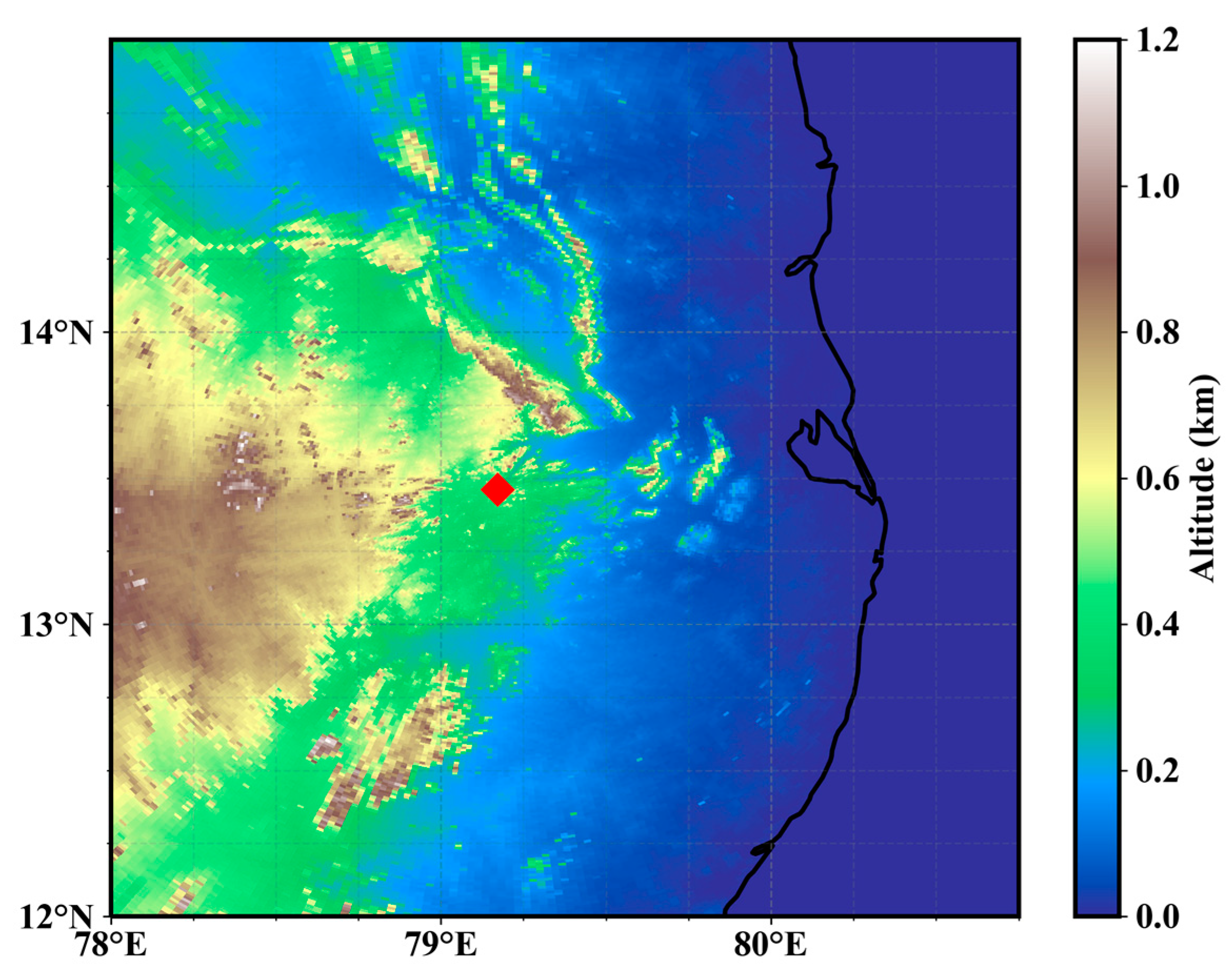
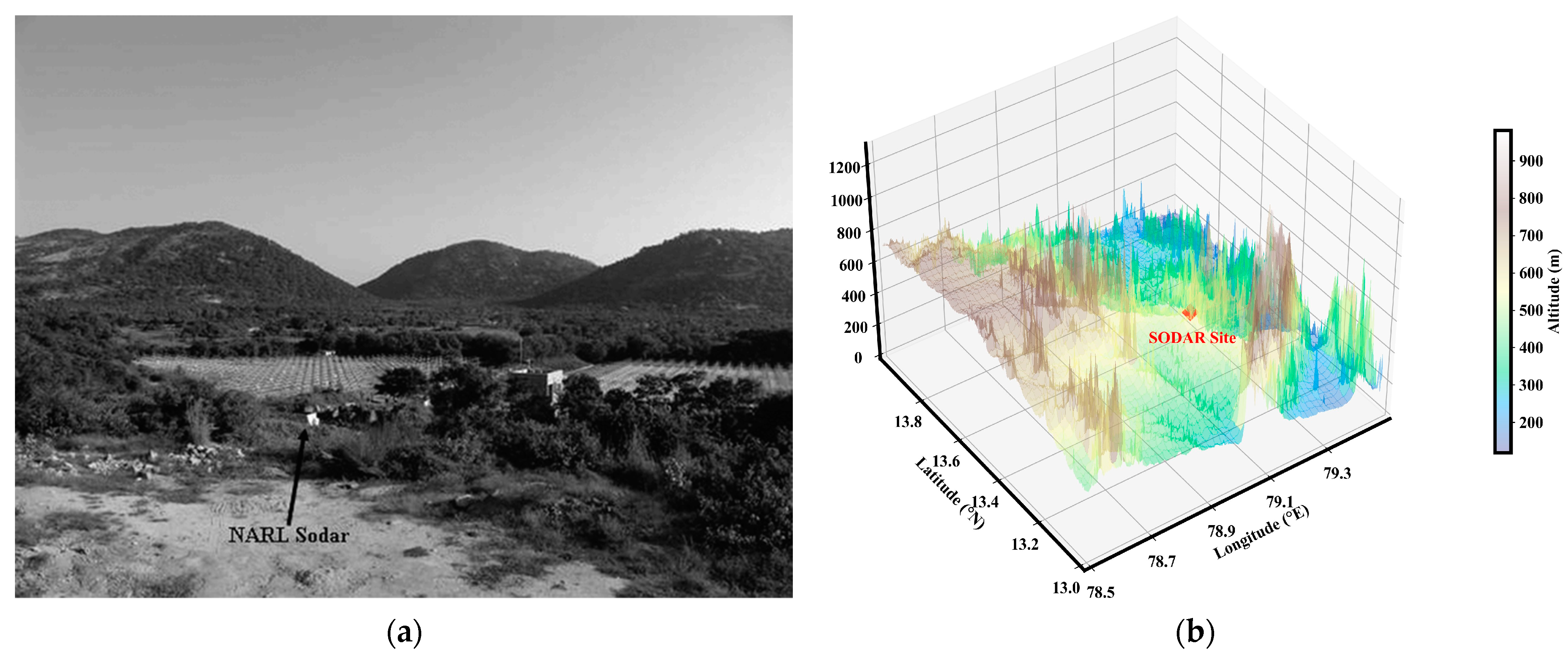
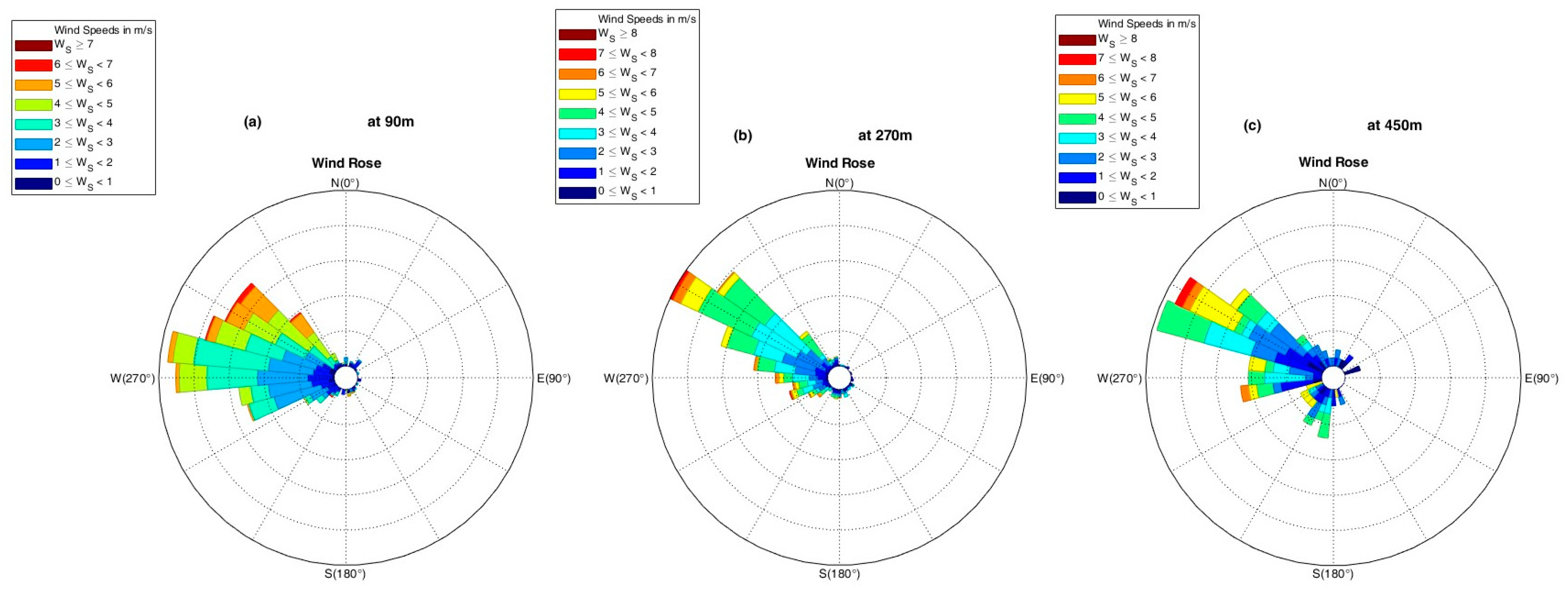
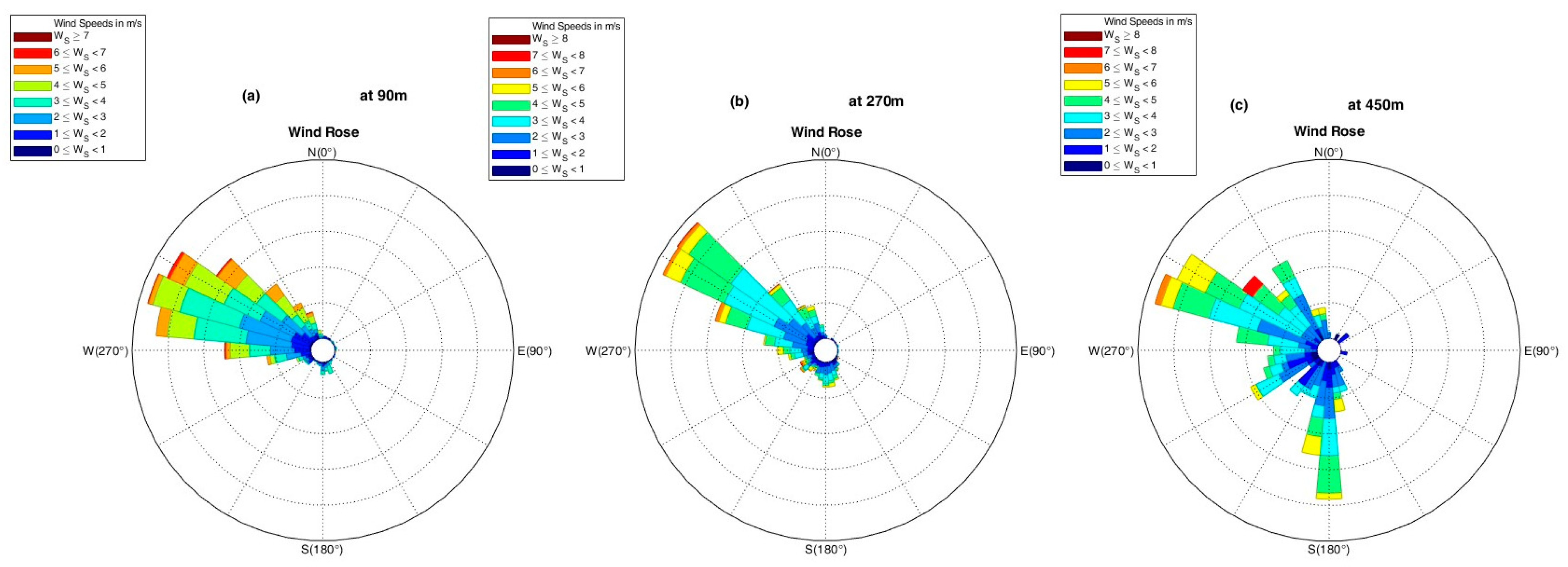
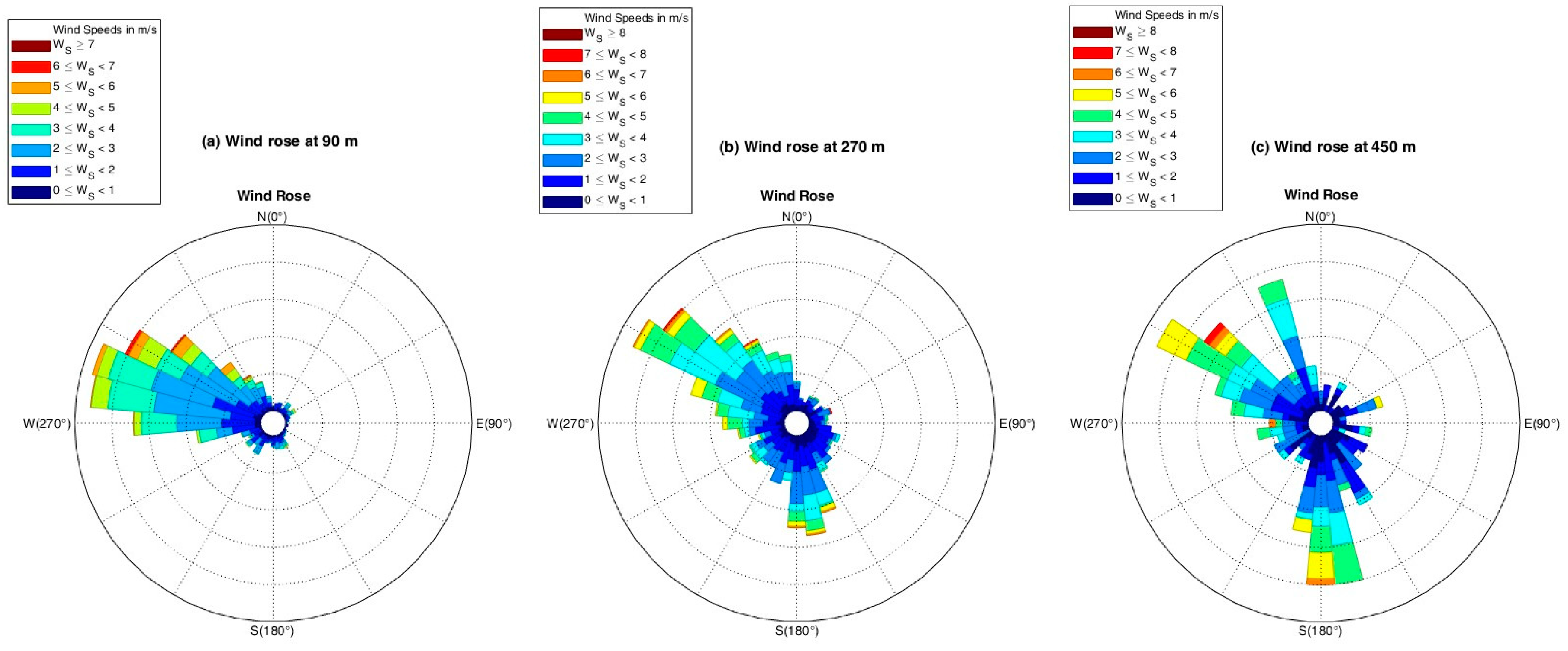
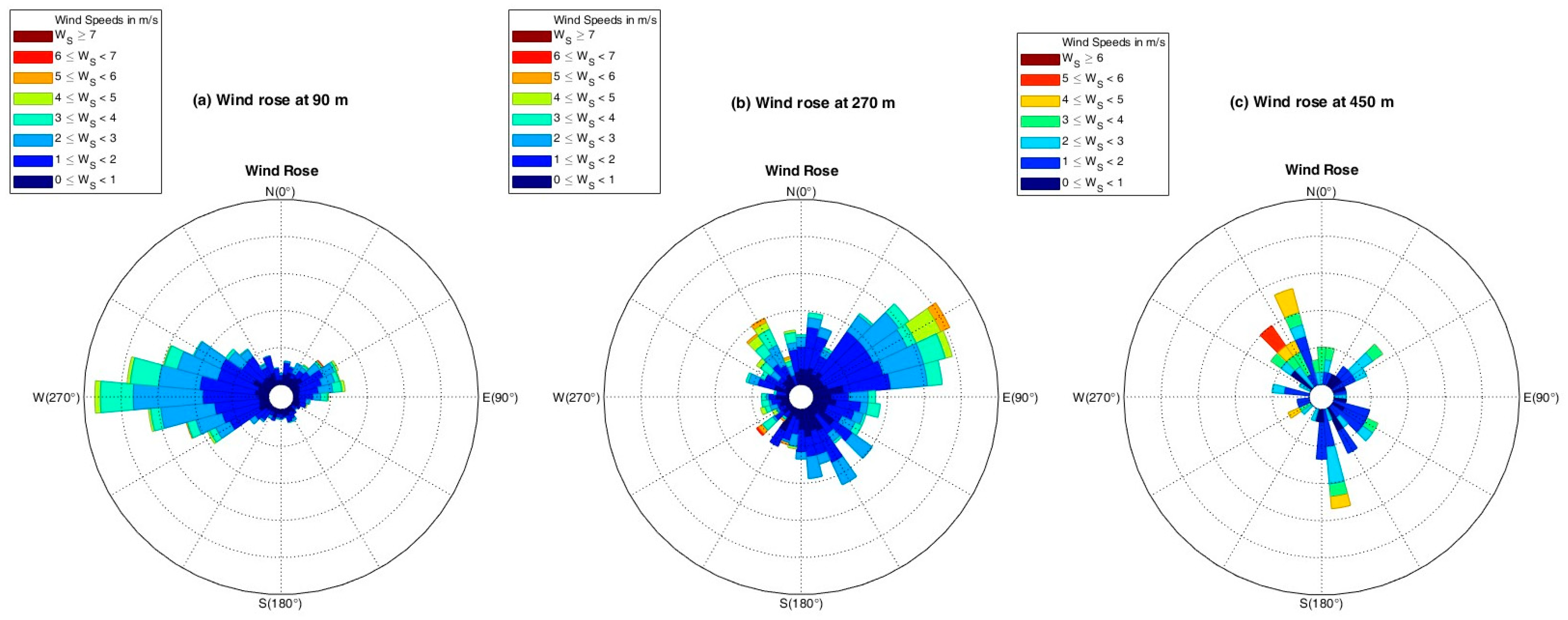
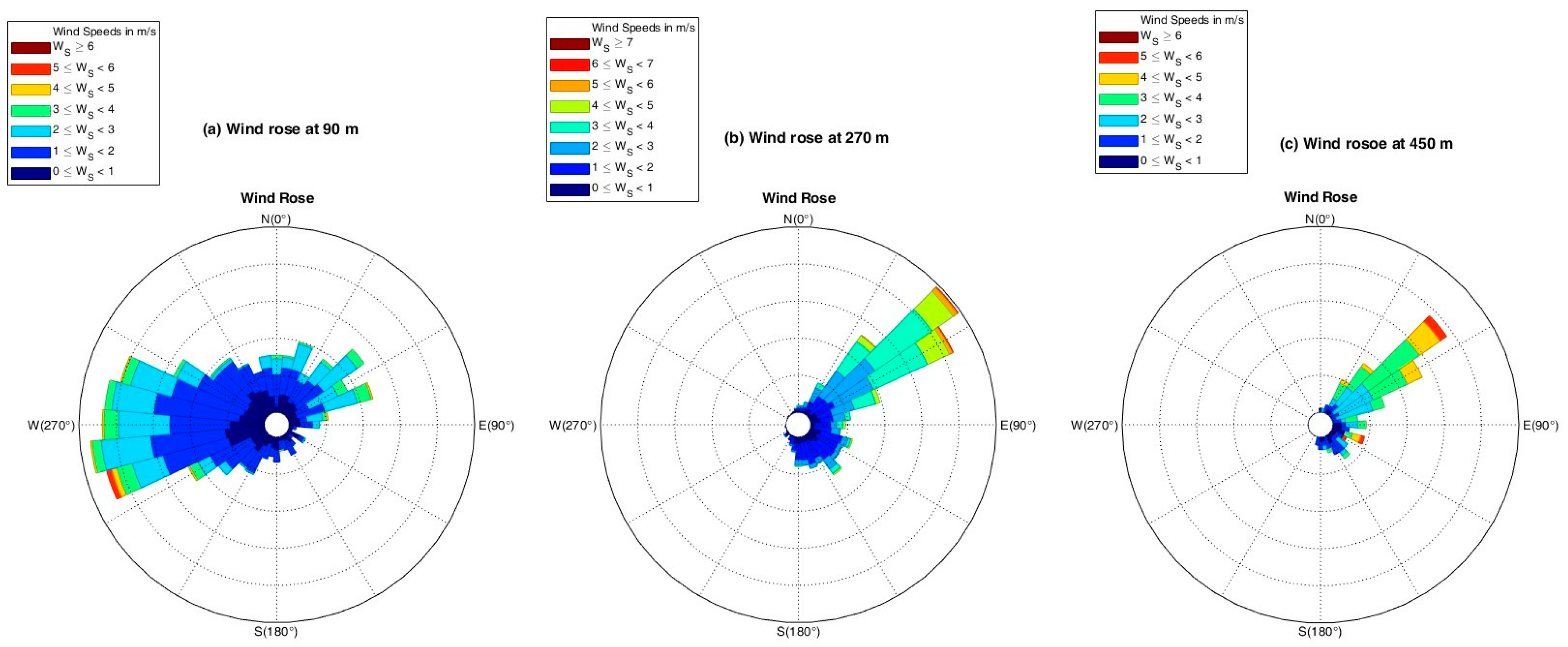
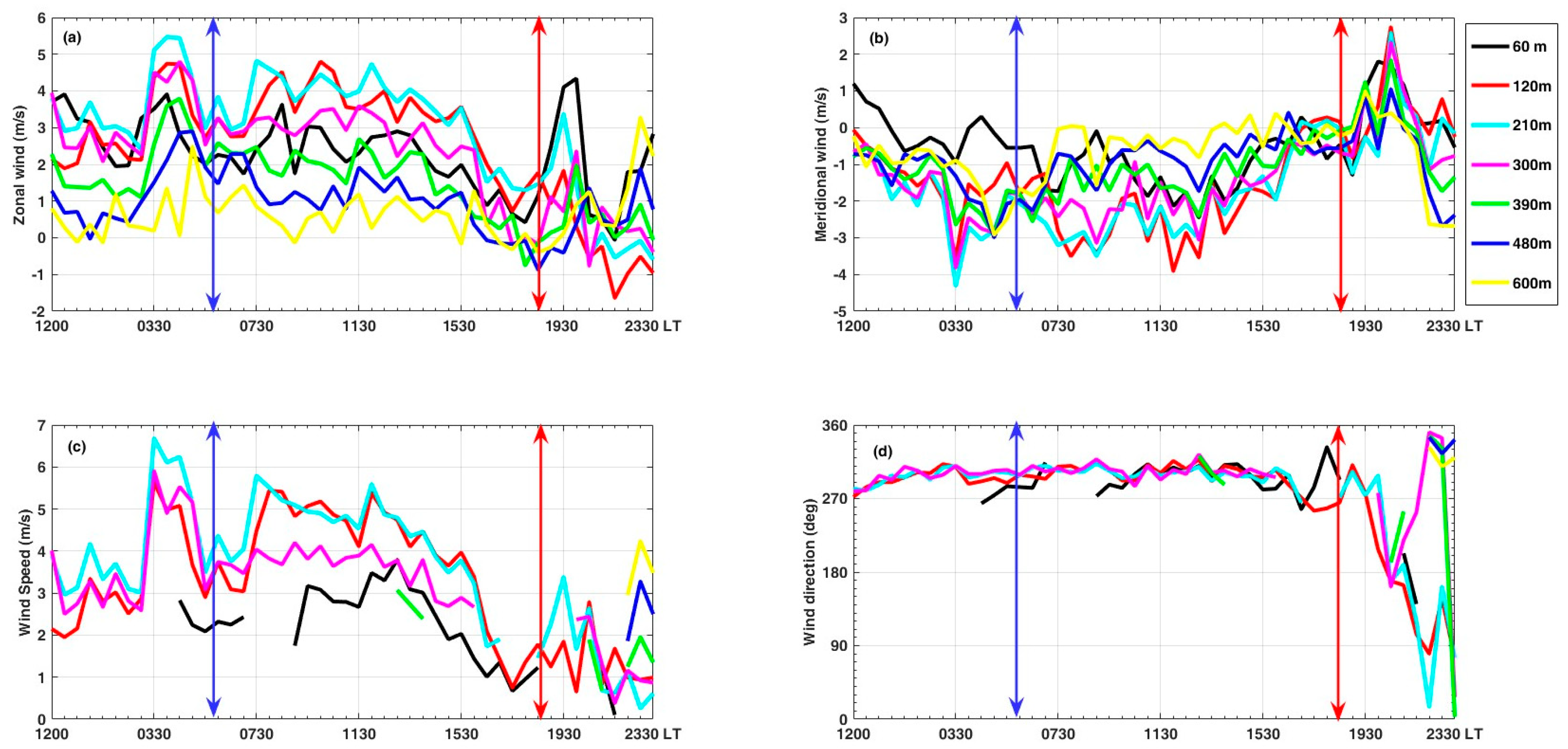
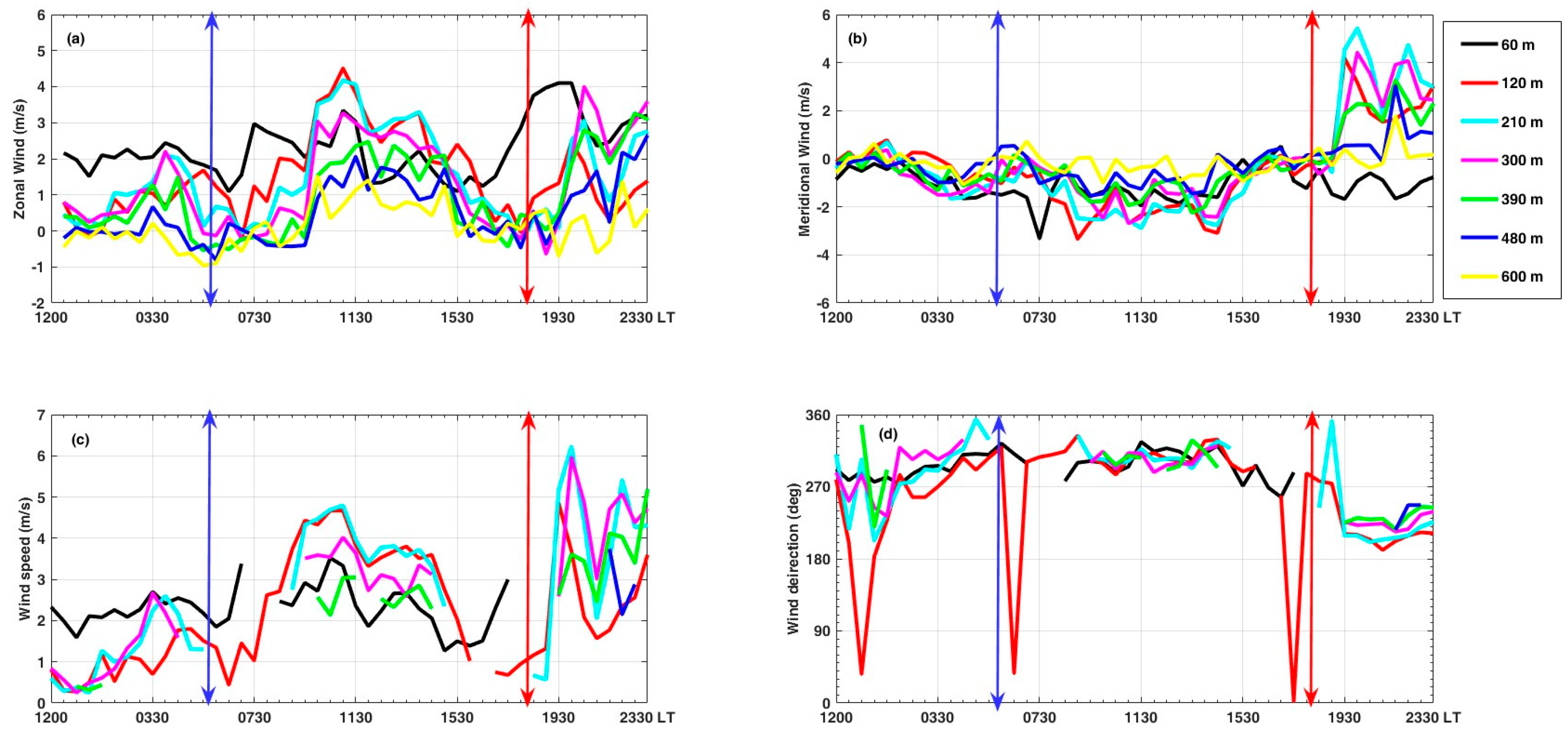
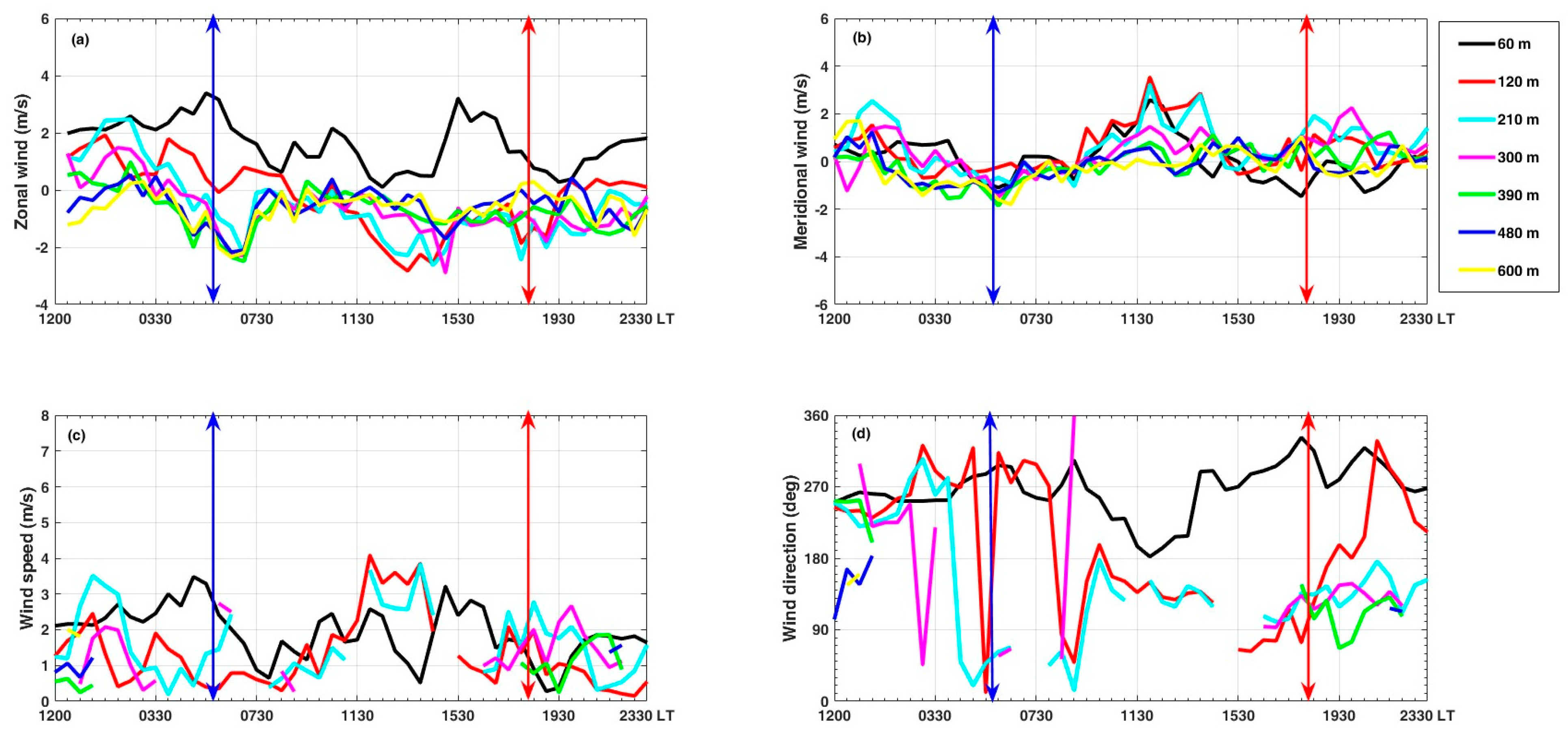

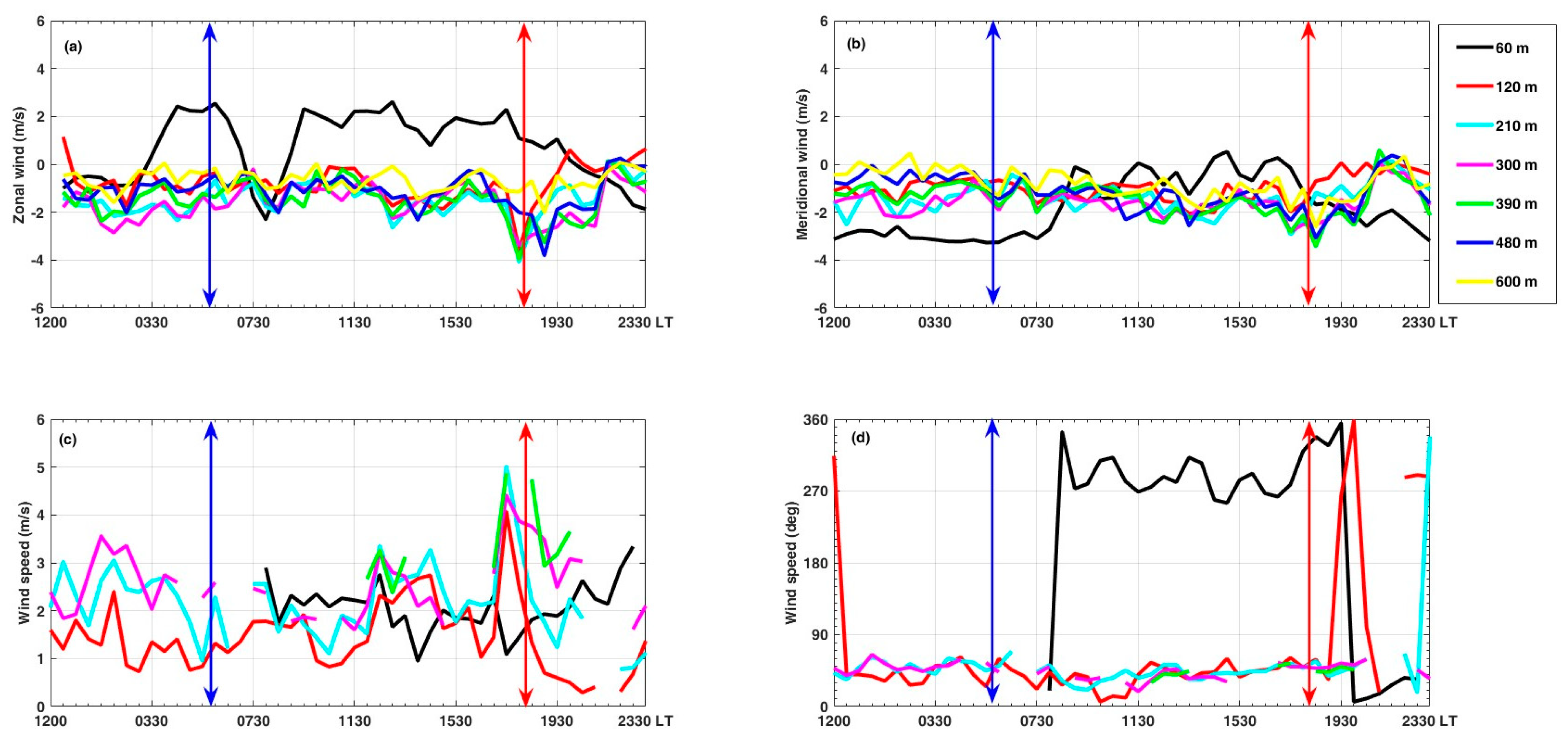
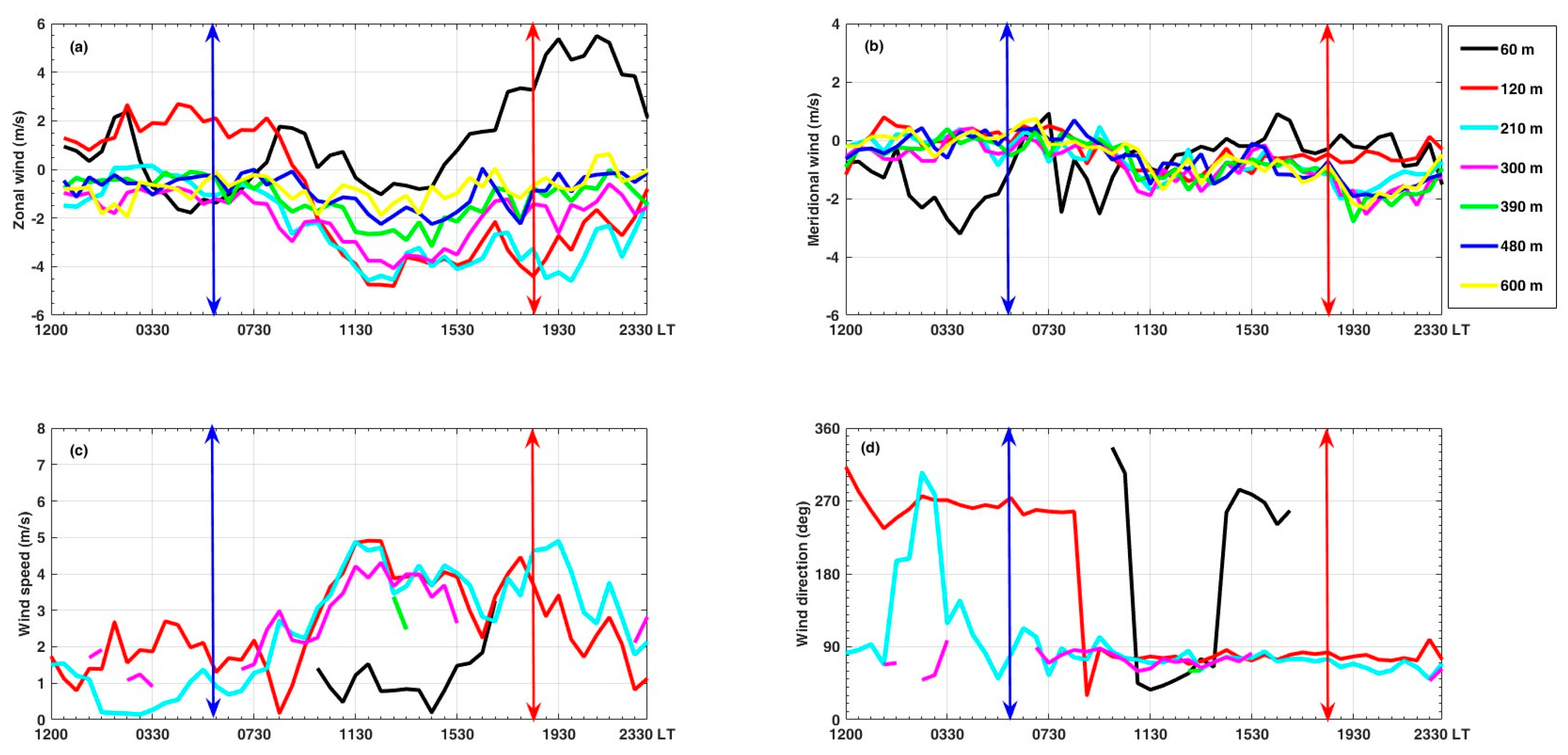
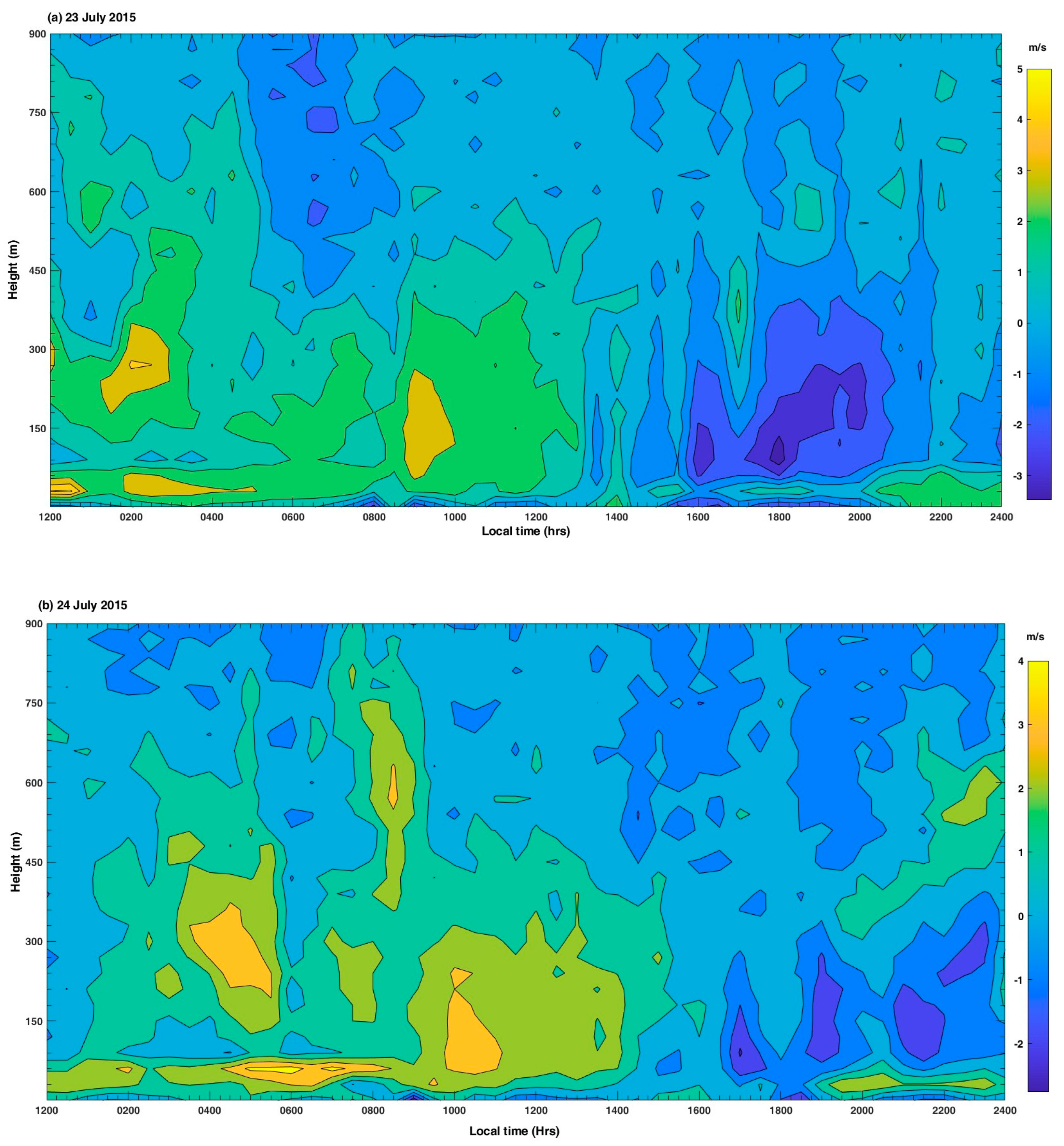
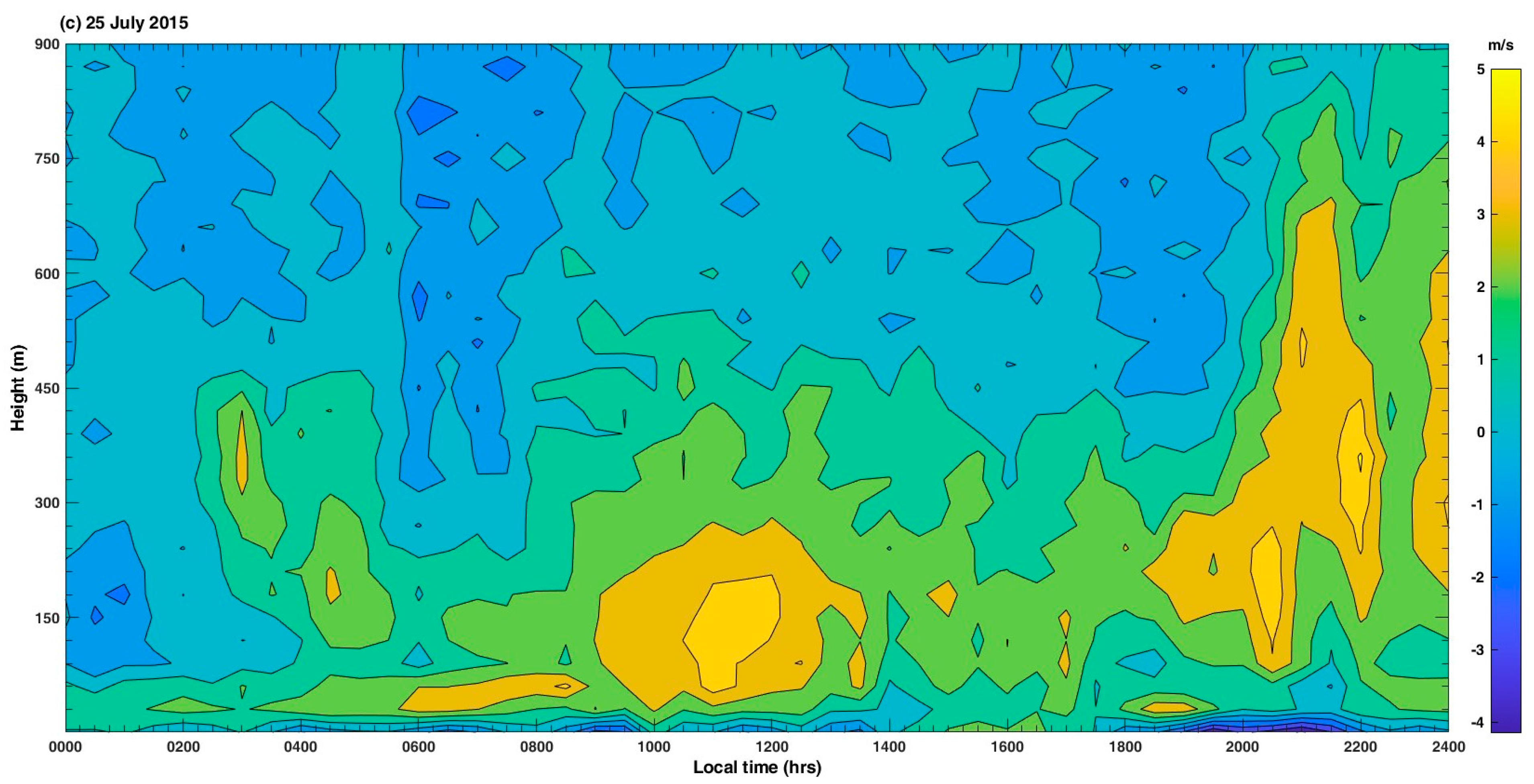
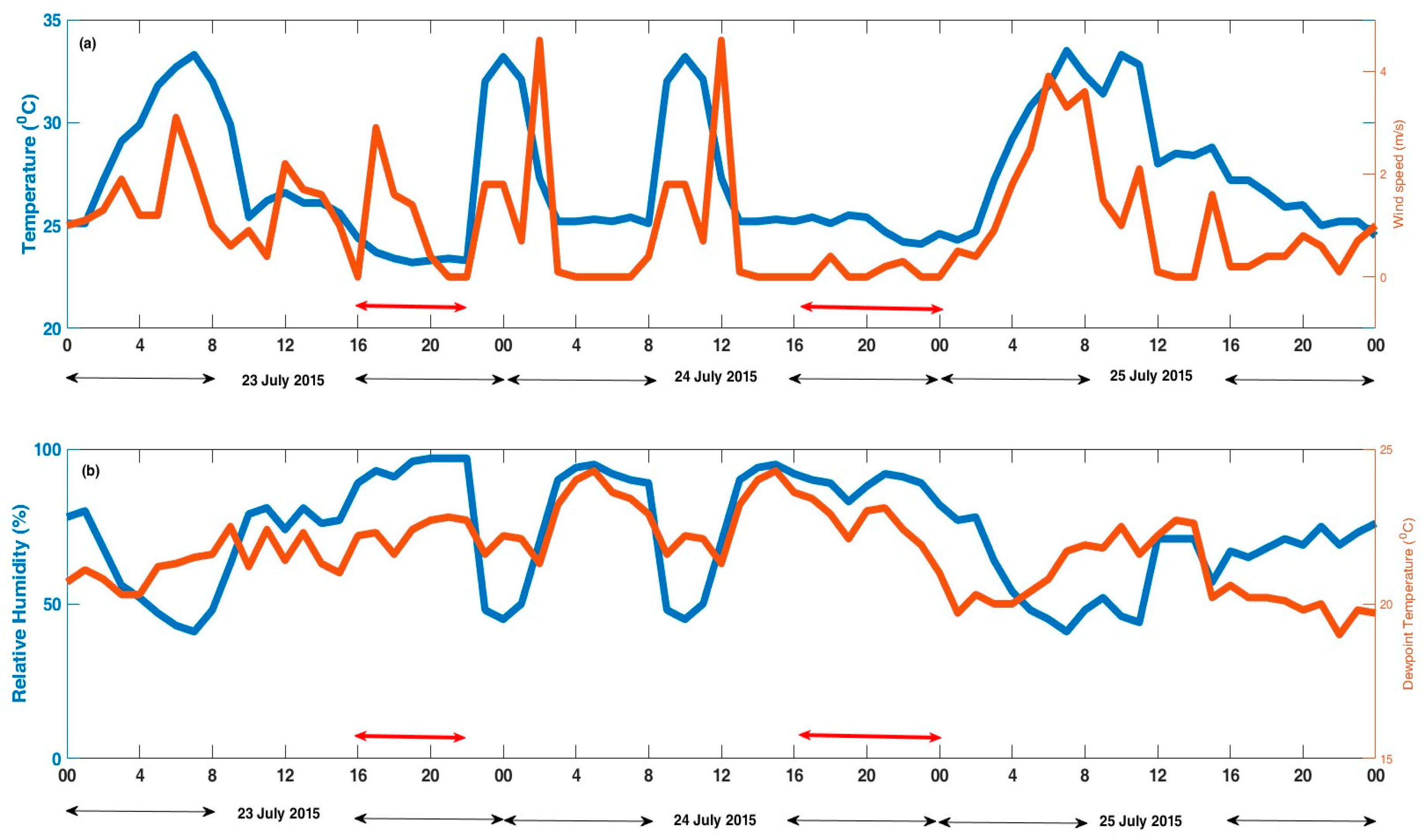

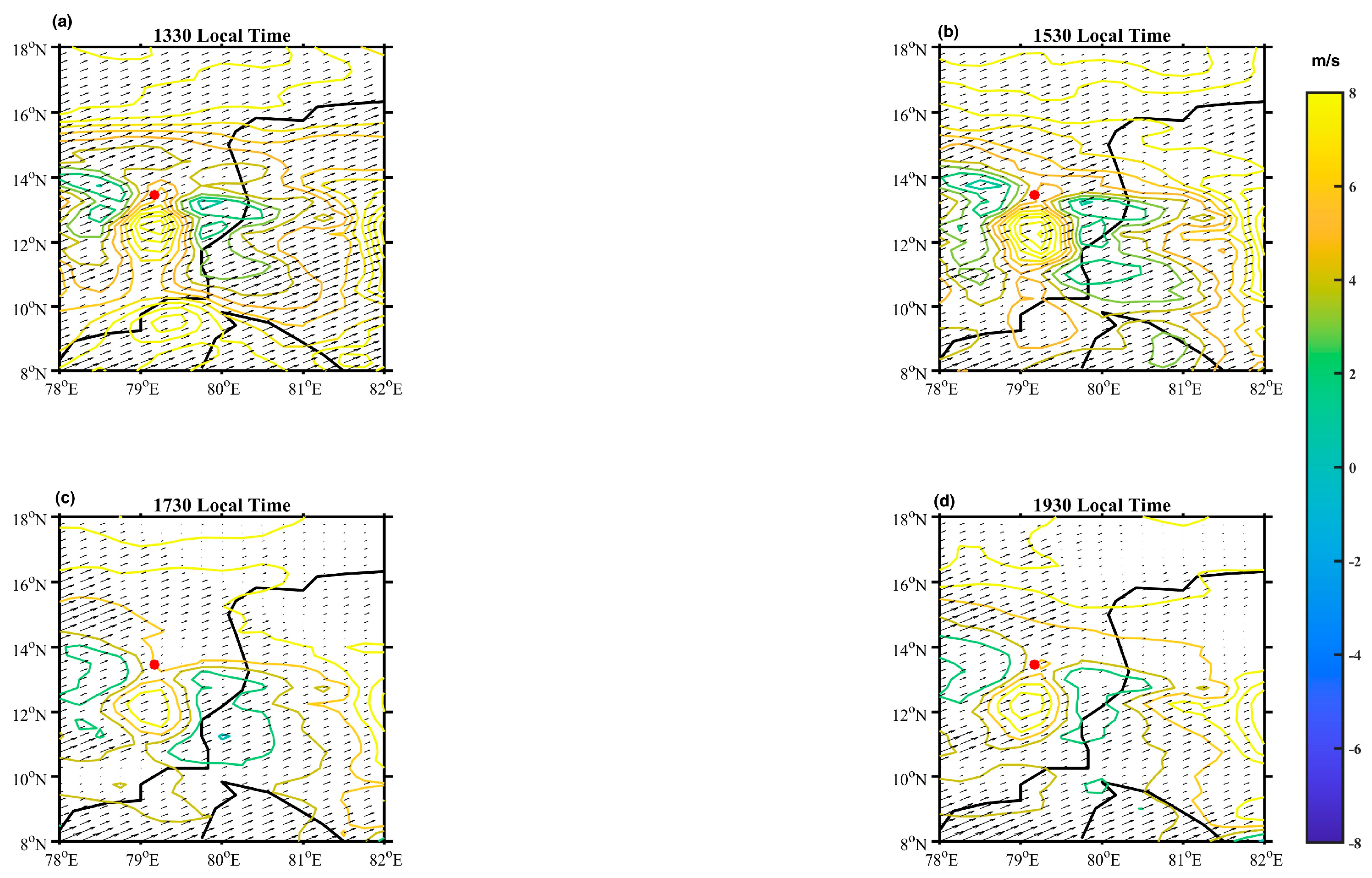
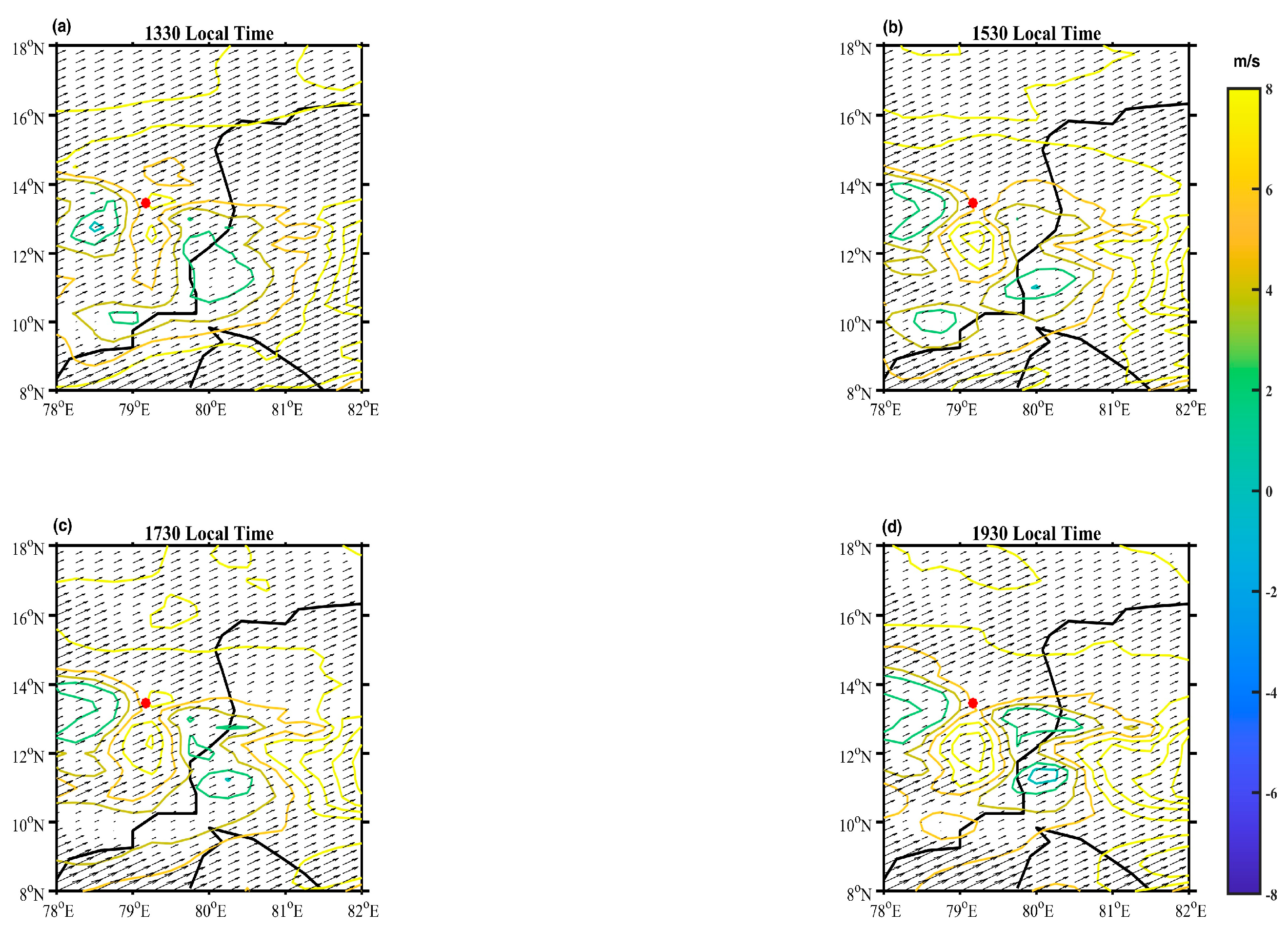
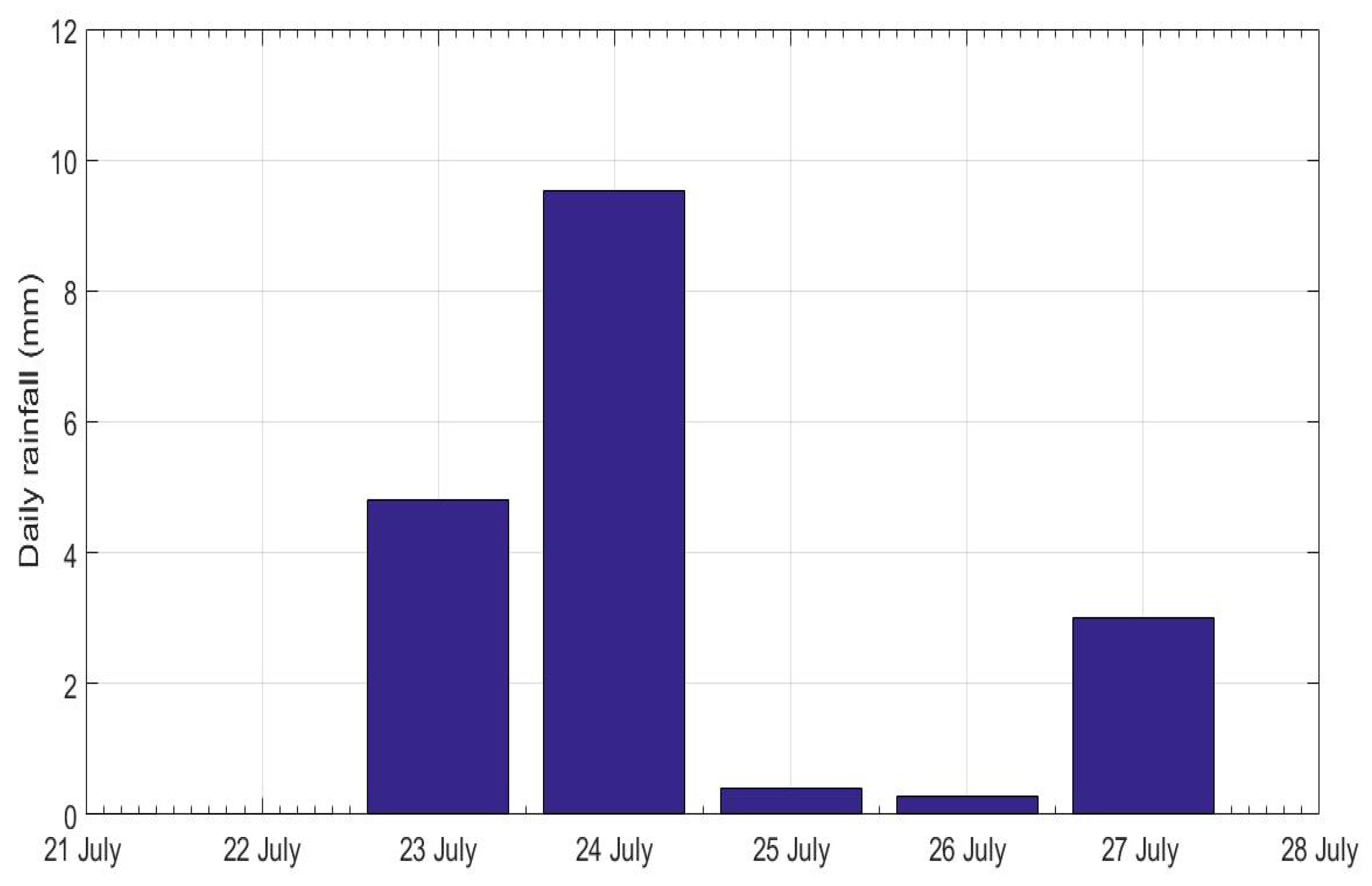
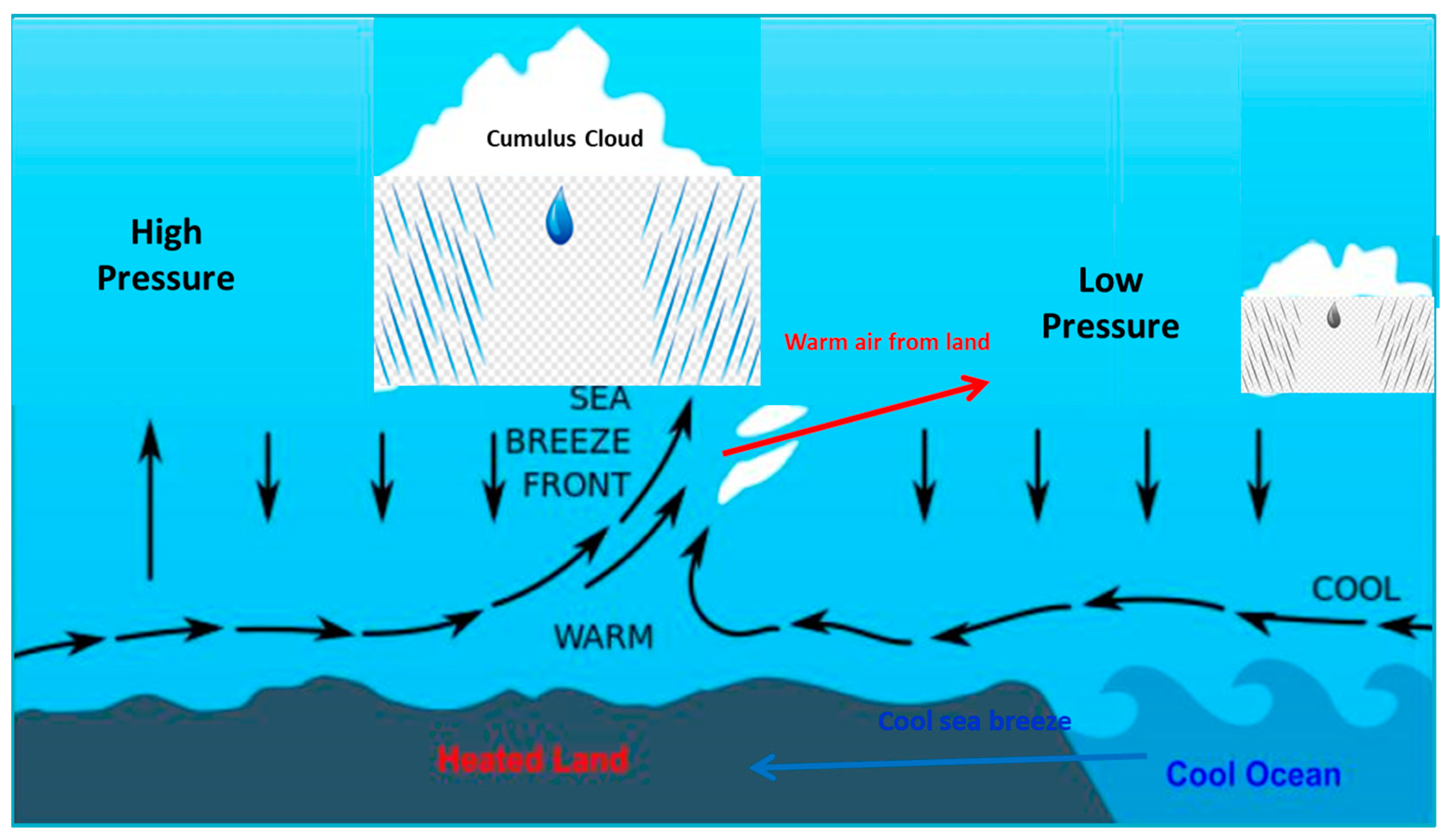
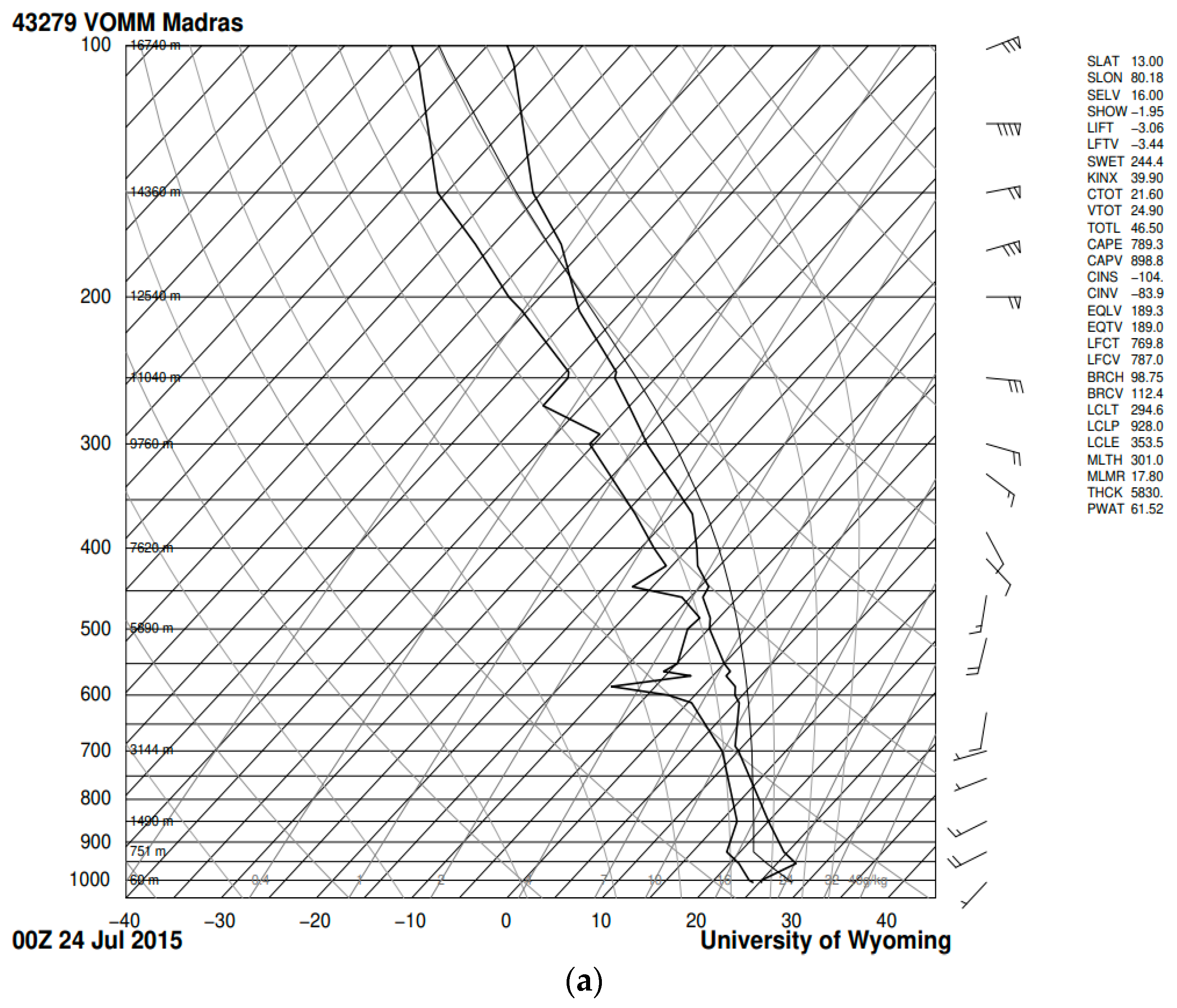
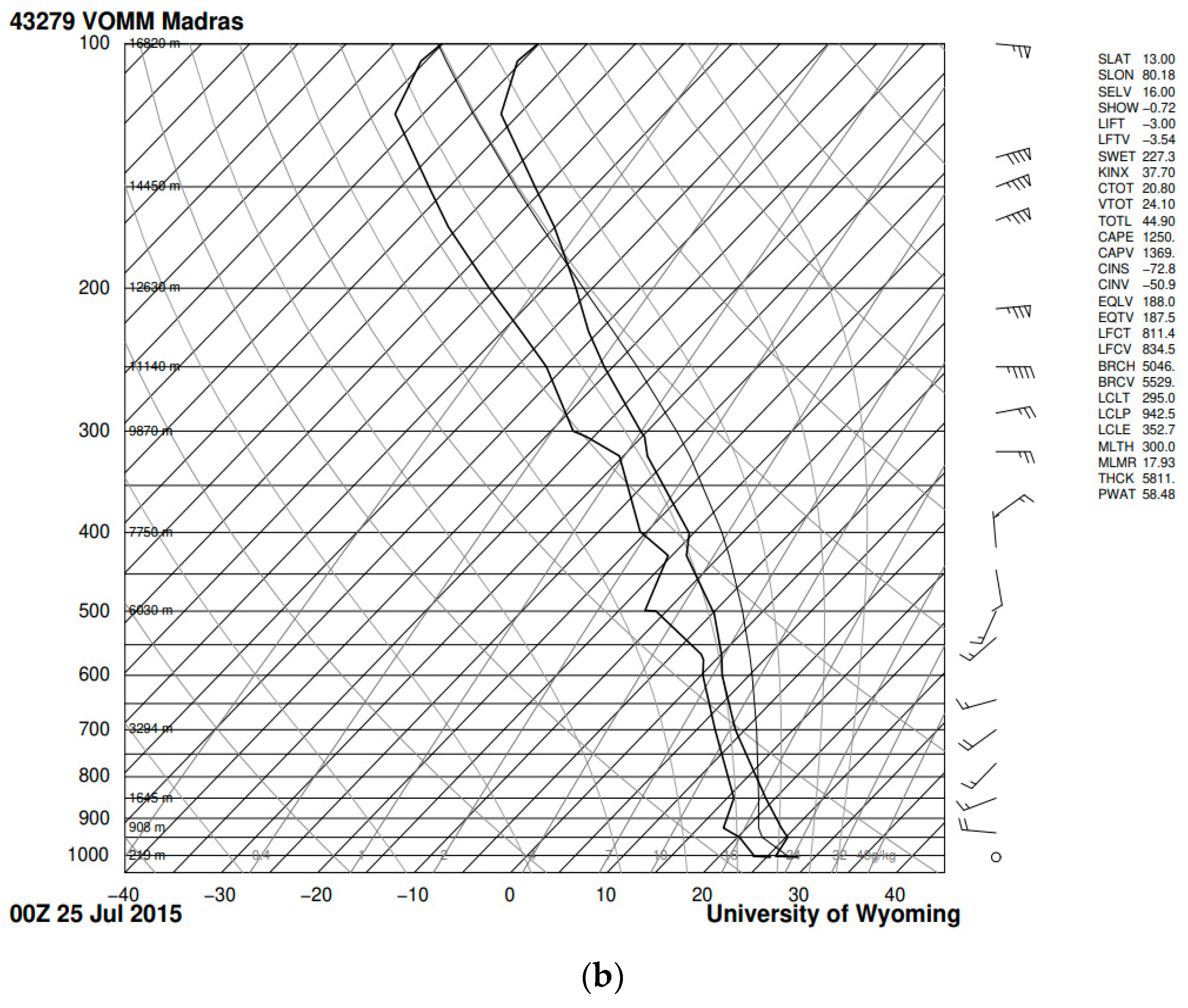
| Parameter | Specification |
|---|---|
| Operating frequency | 1.8 kHz |
| Peak power | 100 W |
| Antenna array | 1 m × 1 m |
| Pulse width | 180 ms |
| Interpulse period | 9 × 106 μs |
| No. of coherent integrations | 1 |
| No. of incoherent integrations | 1 |
| No. of FFT points | 4096 |
| Beam width | 4° |
| Range resolution | 30 m |
| Beam directions | North 16, Zenith, East 16 |
Disclaimer/Publisher’s Note: The statements, opinions and data contained in all publications are solely those of the individual author(s) and contributor(s) and not of MDPI and/or the editor(s). MDPI and/or the editor(s) disclaim responsibility for any injury to people or property resulting from any ideas, methods, instructions or products referred to in the content. |
© 2023 by the authors. Licensee MDPI, Basel, Switzerland. This article is an open access article distributed under the terms and conditions of the Creative Commons Attribution (CC BY) license (https://creativecommons.org/licenses/by/4.0/).
Share and Cite
Brahmanandam, P.S.; Uma, G.; Tarakeswara Rao, K.; Sreedevi, S.; S. M. P. Latha Devi, N.; Chu, Y.-H.; Das, J.; Mahesh Babu, K.; Narendra Babu, A.; Das, S.K.; et al. Doppler Sodar Measured Winds and Sea Breeze Intrusions over Gadanki (13.5° N, 79.2° E), India. Sustainability 2023, 15, 12167. https://doi.org/10.3390/su151612167
Brahmanandam PS, Uma G, Tarakeswara Rao K, Sreedevi S, S. M. P. Latha Devi N, Chu Y-H, Das J, Mahesh Babu K, Narendra Babu A, Das SK, et al. Doppler Sodar Measured Winds and Sea Breeze Intrusions over Gadanki (13.5° N, 79.2° E), India. Sustainability. 2023; 15(16):12167. https://doi.org/10.3390/su151612167
Chicago/Turabian StyleBrahmanandam, Potula Sree, G. Uma, K. Tarakeswara Rao, S. Sreedevi, N. S. M. P. Latha Devi, Yen-Hsyang Chu, Jayshree Das, K. Mahesh Babu, A. Narendra Babu, Subrata Kumar Das, and et al. 2023. "Doppler Sodar Measured Winds and Sea Breeze Intrusions over Gadanki (13.5° N, 79.2° E), India" Sustainability 15, no. 16: 12167. https://doi.org/10.3390/su151612167
APA StyleBrahmanandam, P. S., Uma, G., Tarakeswara Rao, K., Sreedevi, S., S. M. P. Latha Devi, N., Chu, Y.-H., Das, J., Mahesh Babu, K., Narendra Babu, A., Das, S. K., Naveen Kumar, V., & Srinivas, K. (2023). Doppler Sodar Measured Winds and Sea Breeze Intrusions over Gadanki (13.5° N, 79.2° E), India. Sustainability, 15(16), 12167. https://doi.org/10.3390/su151612167







